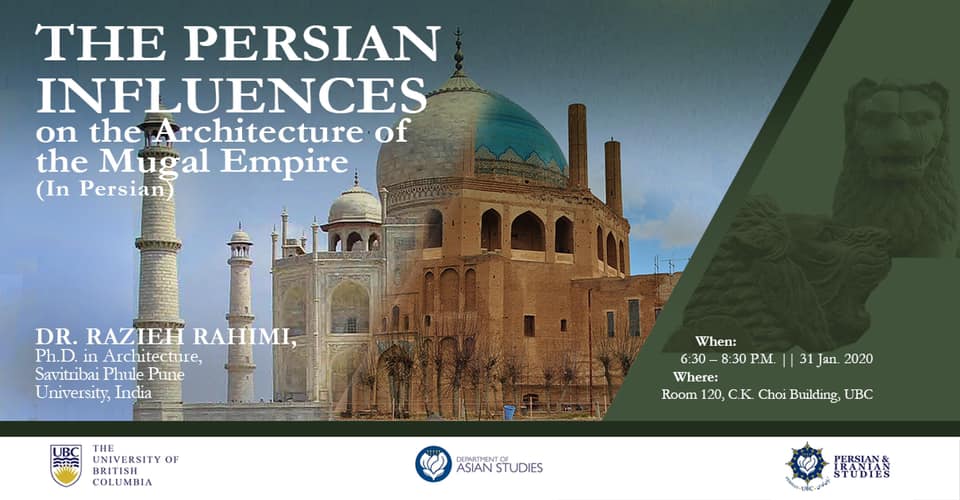

تأثیر هنر ایرانی بر معماریِ امپراتوری گورکانی
سخنران: دکتر راضیه رحیمی، دکترای معماری، دانشگاه ساویتریبای فوله پونا، هند
امپراتوری گورکانی هند یا همان امپراتوری مغول هند، امپراتوری بزرگی بود که در آن نوادگان تیمور در هندوستان از سال ۱۵۲۶ تا ۱۸۵۷ میلادی در بخش بزرگی از شبهقارهٔ هند، از جمله کشورهای امروزی هند، پاکستان، بنگلادش و بخشهایی از افغانستان امروزی فرمانروایی میکردند. این دوران با دورهٔ فرمانروایی سلسلهٔ صفوی در ایران همزمان بوده است. مطالعهٔ دقیق سبک معماری مغول در شبهقارهٔ هند و شباهتهای آن با معماری دورهٔ صفویه در ایران، نشاندهندهٔ تأثیر بسزای فرهنگ و معماری ایران بر سبک جدیدی در معماری کشور هند است. در معماری این دو سلسله شباهتهای زیادی در: ۱- عناصر طراحی، ۲- شباهت در مفهوم طراحی و توجه در برنامهریزی، ۳- جزئیات، ۴- تکنیکهای ساخت، و ۵- هندسه و تقارن وجود دارد که در این جلسه در نگاه کوتاهی به مقایسهٔ آنها خواهیم پرداخت.
A careful study of the Mughal architectural style in the Indian subcontinent and its similarities with Safavid architecture in Iran show the great influence of Iranian culture and architecture on the new style of Indian architecture.
The Gurkani Empire of India, or the Mongol Empire of India, was a large empire in which the descendants of Timor ruled India from 5 to 6 AD in large parts of the Indian subcontinent, including modern-day India, Pakistan, Bangladesh and parts of present-day Afghanistan. This period coincided with the era of the Safavid dynasty in Iran. The official language of the Mughal court of India, Persian language and hence spread Iranian culture and architecture in the Indian subcontinent. The Mughal Empire of India was dependent on Iranian culture for various reasons and aspects, for example, Babur had been living in Iran for many years with Timur’s offspring and had spent five years in exile with his wife in Iran. Jahangir also had an Iranian wife who played an important role in the development of Iranian art and architecture in India, and Arjmand Bano, wife of Shah Jahan, was an Iranian prince who played an important role in encouraging Iranian artists to migrate to India to develop Iranian art and architecture.
Iranian culture, along with Iranian architecture, created a vast area during the Mongol era in the north of India, culminating in the reign of Akbarshah, Homayoun, and Jahangir. The influence of Iranian architecture can be seen in many buildings of the conquered Purskari, Agra and Delhi complexes, which combine a new style into a single structure. In the architecture of this era there are many similarities in domes, columns, public spaces and interior and exterior decorations with Iranian architecture in the Safavid era. During the reign of Shah Jahan, a new capital was designed and built by Iranian architects who used the Mongol kings of Isfahan during the reign of Shah Abbas as a model for the development of their new capital in Delhi.
Iranian artists have introduced new architectural styles in keeping with the Indian climate using local architectural structures whose beautiful examples are visible in castles, mosques, tombs of the time. The best example of this masterpiece is the Taj Mahal in Agra, which is known as an Iranian spirit in the Indian body. However, it should be noted that this cultural influence is not a constant phenomenon and is a solitary phenomenon.
Speaker: Dr. Razieh Rahimi, Ph.D. in Architecture, Savitribai Phule Pune University, India
Should you have any questions, please contact the Department of Asian Studies at Asian.Studies@ubc.ca.